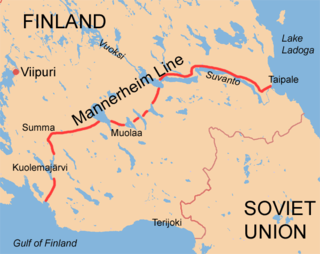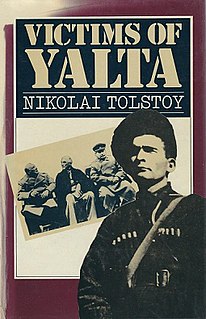Related Research Articles

The Continuation War, also known as the Second Soviet-Finnish War, was a conflict fought by Finland and Nazi Germany against the Soviet Union from 1941 to 1944, as part of World War II. In Soviet historiography, the war was called the Finnish Front of the Great Patriotic War. Germany regarded its operations in the region as part of its overall war efforts on the Eastern Front and provided Finland with critical material support and military assistance, including economic aid.

The Winter War, also known as the First Soviet-Finnish War, was a war between the Soviet Union and Finland. The war began with a Soviet invasion of Finland on 30 November 1939, three months after the outbreak of World War II, and ended three-and-a-half months later with the Moscow Peace Treaty on 13 March 1940. Despite superior military strength, especially in tanks and aircraft, the Soviet Union suffered severe losses and initially made little headway. The League of Nations deemed the attack illegal and expelled the Soviet Union from the organisation.

The Mannerheim Line was a defensive fortification line on the Karelian Isthmus built by Finland against the Soviet Union. While this was never an officially designated name, during the Winter War it became known as the Mannerheim Line, after Finnish Army's then commander-in-chief Field Marshal Baron Carl Gustaf Emil Mannerheim. The line was constructed in two phases: 1920–1924 and 1932–1939. By November 1939, when the Winter War began, the line was by no means complete.
The 3rd Division was a unit of the Finnish Army during the Continuation War. It initially fought in the northern Finland, participating in the Finno-German Operation Arctic Fox. In 1944, it was transferred to the Karelian Isthmus to defend against the Soviet Vyborg–Petrozavodsk offensive. Following the Moscow Armistice in 1944, the division was moved to Oulu and participated in the Lapland War.

Greater Finland, an irredentist and nationalist idea, emphasized territorial expansion of Finland. The most common concept of Greater Finland saw the country as defined by natural borders encompassing the territories inhabited by Finns and Karelians, ranging from the White Sea to Lake Onega and along the Svir River and Neva River—or, more modestly, the Sestra River—to the Gulf of Finland. Some proponents also included the Torne Valley, Ingria, and Estonia.

The war crimes which were perpetrated by the Soviet Union and its armed forces from 1919 to 1991 include acts which were committed by the Red Army as well as acts which were committed by the NKVD, including acts which were committed by the NKVD's Internal Troops. In some cases, these acts were committed upon the orders of the Soviet leader Joseph Stalin in pursuance of the early Soviet Government's policy of Red Terror. In other instances they were committed without orders by Soviet troops against prisoners of war or civilians of countries that had been in armed conflict with the USSR, or they were committed during partisan warfare.

During World War II, Nazi Germany engaged in a policy of deliberate maltreatment of Soviet prisoners of war (POWs), in contrast to their treatment of British and American POWs. This policy, which amounted to deliberately starving and working to death Soviet POWs, was grounded in Nazi racial theory, which depicted Slavs as sub-humans (Untermenschen). The policy resulted in some 3.3 to 3.5 million deaths.
The Main Administration for Affairs of Prisoners of War and Internees was an NKVD department in charge of handling of foreign civilian internees and prisoners of war (POWs) in the Soviet Union during and in the aftermath of World War II (1939–1953).
Einsatzkommando Finnland was a German paramilitary unit active in northern Finland and northern Norway during World War II, while Finland was fighting against the Soviet Union with the support of Nazi Germany. The official name of the unit was Einsatzkommando der Sicherheitspolizei und des SD beim AOK Norwegen, Befehlsstelle Finnland, but it was often referred to as Einsatzkommando Finnland.
The GULAG Operation was a German military operation in which German and Soviet anti-communist troops were to create an anti-Soviet resistance movement in Siberia during World War II by liberating and recruiting prisoners of the Soviet GULAG system. Despite ambitious plans, only a small group of former Soviet POWs was airlifted to the Komi Republic in June 1943. Members of the group were captured or killed days after landing.

World War II losses of the Soviet Union from all related causes were about 27,000,000 both civilian and military, although exact figures are disputed. A figure of 20 million was considered official during the Soviet era. The post-Soviet government of Russia puts the Soviet war losses at 26.6 million, on the basis of the 1993 study by the Russian Academy of Sciences, including people dying as a result of effects of the war. This includes 8,668,400 military deaths as calculated by the Russian Ministry of Defence.

Victims of Yalta or The Secret Betrayal is a 1977 book by Nikolai Tolstoy that chronicles the fate of Soviet citizens who had been under German control during World War II and at its end fallen into the hands of the Western Allies. According to the secret Moscow agreement from 1944 that was confirmed at the 1945 Yalta conference, all citizens of the Soviet Union were to be repatriated without choice—a death sentence for many by execution or extermination through labour.

Approximately three million German prisoners of war were captured by the Soviet Union during World War II, most of them during the great advances of the Red Army in the last year of the war. The POWs were employed as forced labor in the Soviet wartime economy and post-war reconstruction. By 1950 almost all surviving POWs had been released, with the last prisoner returning from the USSR in 1956. According to Soviet records 381,067 German Wehrmacht POWs died in NKVD camps. A commission set up by the West German government found that 3,060,000 German military personnel were taken prisoner by the USSR and that 1,094,250 died in captivity. According to German historian Rüdiger Overmans ca. 3,000,000 POWs were taken by the USSR; he put the "maximum" number of German POW deaths in Soviet hands at 1.0 million. Based on his research, Overmans believes that the deaths of 363,000 POWs in Soviet captivity can be confirmed by the files of Deutsche Dienststelle (WASt), and additionally maintains that "It seems entirely plausible, while not provable, that 700,000 German military personnel listed as missing actually died in Soviet custody."
East Karelian concentration camps were a set of concentration camps operated by the Finnish government in the areas of the Soviet Union occupied by the Finnish military administration during the Continuation War. These camps were organized by the armed forces supreme commander Carl Gustaf Emil Mannerheim. The camps were intended to hold camp detainees for future exchange with the Finnic population from the rest of Russia. The mortality rate of civilians in the camps was high due to famine and disease: by some estimates, 4279 civilians died in these camps, meaning a rough mortality rate of 17%.

The Finnish military administration in Eastern Karelia was an interim administrative system established in those areas of the Karelo-Finnish Soviet Socialist Republic (KFSSR) of the Soviet Union which were occupied by the Finnish army during the Continuation War. The military administration was set up on 15 July 1941 and it ended during the summer of 1944. The goal of the administration was to prepare the region for eventual annexation by Finland.

Soviet prisoners of war in Finland during World War II were captured in two Soviet-Finnish conflicts of that period: the Winter War and the Continuation War. The Finns took about 5,700 POWs during the Winter War, and due to the short length of the war they survived relatively well. However, during the Continuation War the Finns took 64,000 POWs, of whom almost 30 percent died.

Taavetti Laatikainen was a Finnish General of Infantry and a member of the Jäger movement. He fought in the Eastern Front of World War I, the Finnish Civil War, the Winter War and the Continuation War. During the last of these, he was awarded the Mannerheim Cross of Liberty 2nd Class. Before the Winter War, he commanded both the Reserve Officer School and the Officer Cadet School. He retired in 1948 from the position of Inspector of Infantry.
The I Corps refers to several short-lived units of the Finnish Army before and during the Continuation War. The longest-lived I Corps participated in both the Finnish invasion of Ladoga Karelia and the Finnish invasion of the Karelian Isthmus in 1941 before being disbanded in early 1942, before being re-designated V Corps.
The II Corps was a unit of the Finnish Army during the Continuation War. During the war the corps participated in combat first northwest of Lake Ladoga and on the Karelian Isthmus before moving to the Povenets–Lake Segozero region by late 1941. During the Soviet offensive of 1944, the corps conducted a fighting retreat to the region of Ilomantsi, with parts of its forces participating in the subsequent Battle of Ilomantsi.
The IV Corps was a unit of the Finnish Army during the Continuation War. During the 1941 Finnish invasion of the Karelian Isthmus, it encircled three Soviet divisions in the area south of Vyborg before being disbanded. Reconstituted in 1944, the corps was the target of the spearhead of the Soviet Vyborg–Petrozavodsk offensive. Elements of the corps fought in the decisive Battle of Tali-Ihantala at the end of the war.
References
- ↑ V. Galitsky (1997) "Finnish Prisoners of War in NKVD Camps (1939–1953)" ISBN 5-7873-0005-X (in Russian)
- 1 2 3 Finnish POW during the World War II, Viktor Konasov, North magazine ("Север") no. 11–12, 2002 (in Russian)
- 1 2 Malmi, Timo (2005). "Jatkosodan suomalaiset sotavangit". In Leskinen, Jari; Juutilainen, Antti (eds.). Jatkosodan pikkujättiläinen (in Finnish) (1st ed.). Werner Söderström Osakeyhtiö. pp. 1022–1032. ISBN 951-0-28690-7.
- ↑ Nikkilä, Reijo (2002). Alava, Teuvo; Frolov, Dmitri; Nikkilä, Reijo (eds.). Rukiver!: Suomalaiset sotavangit Neuvostoliitossa (in Finnish). Edita. p. 17. ISBN 951-37-3706-3.
- ↑ Frolov, Dmitri (2002). "Sotavankilainsäädäntö Neuvostoliitos vuosina 1939–1944". In Alava, Teuvo; Frolov, Dmitri; Nikkilä, Reijo (eds.). Rukiver!: Suomalaiset sotavangit Neuvostoliitossa (in Finnish). Edita. pp. 58–59. ISBN 951-37-3706-3.